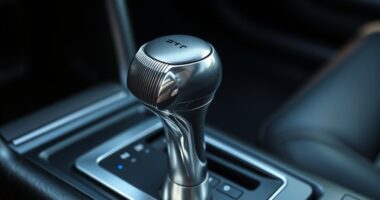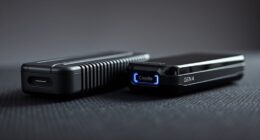Installing an exhaust wrap on your Subaru Outback or Forester can boost performance by increasing exhaust gas temperatures, improving flow, and reducing turbo lag. It also helps safeguard engine components from heat damage by distributing heat evenly and lowering overall bay temperatures. Choosing high-quality materials like fiberglass or titanium guarantees durability and safety. Proper installation can enhance your vehicle’s efficiency and longevity. Keep exploring to uncover detailed tips and options for your Subaru.
Key Takeaways
- Exhaust wraps boost performance by increasing exhaust gas temperatures, improving flow, and reducing turbo lag in Subaru Outback and Forester models.
- Choose high-quality materials like fiberglass, titanium, or basalt wraps for durability, heat resistance, and compatibility with Subaru exhaust systems.
- Proper installation involves cleaning headers, wrapping tightly with overlaps, and securing with ties to ensure effective heat retention and safety.
- Exhaust wraps help lower engine bay temperatures, protect components from heat damage, and improve overall engine efficiency.
- Cost-effective and compatible, these wraps enhance horsepower, reduce heat soak, and extend the lifespan of Subaru Outback and Forester exhaust components.
Benefits of Installing Exhaust Wraps on Subaru Outback and Forester

Installing exhaust wraps on your Subaru Outback or Forester offers several tangible benefits. First, it boosts exhaust performance by increasing exhaust gas temperatures, which helps gases flow faster and improves scavenging from engine cylinders. This translates to more power and better combustion efficiency. Additionally, exhaust wraps reduce under-hood temperatures, protecting sensitive components from heat damage and extending their lifespan. For turbocharged models, they decrease turbo lag by maintaining higher exhaust temperatures, resulting in quicker spool times. The wraps also enhance the vehicle’s look with customizable colors and finishes, giving your Subaru a more aggressive or personalized appearance. Incorporating heat management techniques like exhaust wraps is increasingly popular among enthusiasts seeking to optimize their vehicle’s performance and longevity. Proper heat control can also contribute to engine reliability, making your vehicle more resilient under demanding conditions. Using heat-resistant materials can further improve overall thermal efficiency, ensuring your engine remains cooler and more efficient during operation. Overall, exhaust wraps help improve engine reliability, increase power potential, and keep your engine bay cooler, making them a smart upgrade for performance-minded Subaru owners.
Choosing the Right Materials for Subaru Exhaust Wraps
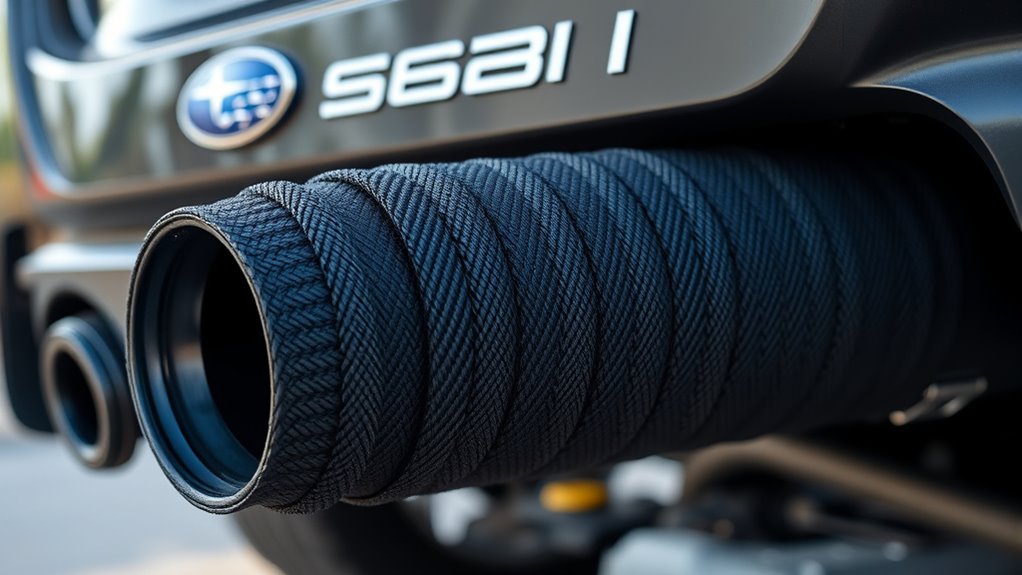
Selecting the appropriate material for your Subaru exhaust wrap is essential to maximize heat management and durability. Fiberglass wraps are popular, offering good insulation and the option for specialist coatings to handle higher temps. Lava rock (basalt) wraps are highly pliable, resist oil spills, and withstand temperatures up to 2500°F intermittently, making them ideal for rugged conditions. Titanium wraps, also made from basalt, are durable and resistant to vibration and spills. Ceramic coatings excel at retaining heat within pipes but don’t release it as effectively as wraps. Reflective wraps incorporate materials that reflect radiant heat, further enhancing thermal control. When choosing, consider your Subaru’s exhaust temperatures, the environment, and installation needs to ensure your wrap provides ideal heat resistance, flexibility, and longevity. Understanding trust issues in relationships can also be relevant when dealing with maintenance or repairs to ensure honesty and transparency in your vehicle care. Additionally, selecting the right safety standards and proper installation techniques can significantly improve the effectiveness and lifespan of your exhaust wrap. Proper installation techniques are crucial to prevent heat leaks and ensure maximum protection for your engine components. Consulting manufacturer recommendations can also help you select the most compatible and reliable materials for your specific vehicle model.
Compatibility and Fitment With Subaru Header Systems
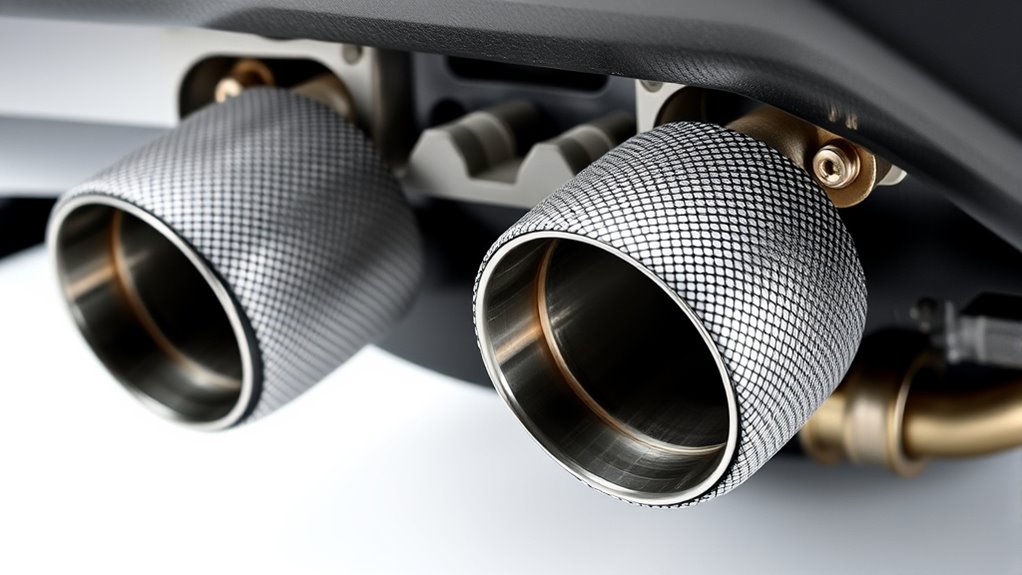
Exhaust wraps are designed to fit around existing Subaru header systems, making compatibility straightforward for most models. They come in various sizes, such as 2″ wide by 50 feet long, which can accommodate a medium header. To guarantee a proper fit, you’ll need to measure your header’s dimensions carefully. Both fiberglass and titanium wraps are suitable options, with titanium offering higher heat resistance for turbocharged models. Compatibility also depends on how well the wrap can maintain heat without causing heat soak or interfering with other components. Most wraps include stainless steel zip ties for secure fastening, and their pliability makes installation easier. Proper measurement and selection of the right size will help you achieve a snug fit, maximizing heat retention and performance. Choosing the appropriate heat-resistant materials can ensure durability and optimal function over time. Additionally, considering the proper installation techniques can help prevent potential issues like unraveling or improper heat shielding. Being aware of the WWE Raw’s financial impact can provide insight into how significant and lucrative the industry can be, which is useful when investing in performance modifications. Moreover, selecting wraps with high thermal insulation properties can enhance their effectiveness in heat management.
Installation Tips for Subaru Outback and Forester Exhaust Wraps

Before wrapping your Subaru Outback or Forester headers, it’s vital to prepare properly to guarantee a secure and effective installation. First, gather all necessary materials: fiberglass or titanium wrap, stainless steel ties, clamps, gloves, and safety glasses. Clean the headers thoroughly with a degreaser, ensuring they’re dry and free of grease or debris. Wear protective gear to prevent fiberglass irritation. Lightly dampen the wrap with water to improve flexibility and reduce dust. Use tools like wire cutters, pliers, and a measuring tape to estimate the wrap length. Start wrapping at the exhaust port, folding the wrap at a 45° angle for initial hold. Keep the wrap taut, overlapping each layer by 10-25%, and wrap toward the exhaust flow to prevent loosening. Secure tightly with ties every few inches, especially near bends. Properly installing exhaust wrap can help manage heat and protect surrounding components from heat damage, especially important when considering heat management for vehicle performance. Additionally, understanding asset division can provide insights into how different components or modifications might be allocated or prioritized when customizing vehicle setups. When wrapping, ensure the contrast ratio of your setup is optimized so that the heat reflection does not compromise other components or visuals.
Impact of Exhaust Wraps on Subaru Performance and Efficiency

Wrapping your Subaru headers can substantially boost performance by increasing exhaust gas velocity and enhancing scavenging efficiency. Higher temperatures inside the wrapped headers help expel exhaust gases more quickly, reducing backpressure and improving power output. For turbocharged models, this heat retention minimizes turbo lag by speeding up spool time, leading to faster throttle response. Additionally, improved cylinder evacuation results in more complete combustion, increasing overall engine power. Cooler intake air temperatures from reduced radiant heat enhance air density, boosting combustion efficiency. However, if not properly tuned, over-scavenging might cause lean conditions. While performance gains are evident, it’s important to monitor for potential moisture buildup, which can accelerate corrosion in non-stainless headers. Overall, exhaust wraps can optimize flow and efficiency but require careful consideration of long-term effects. Proper maintenance is essential to prevent issues related to moisture and corrosion, ensuring sustained performance over time.
Ensuring Durability and Safety of Exhaust Wraps in Subaru Vehicles
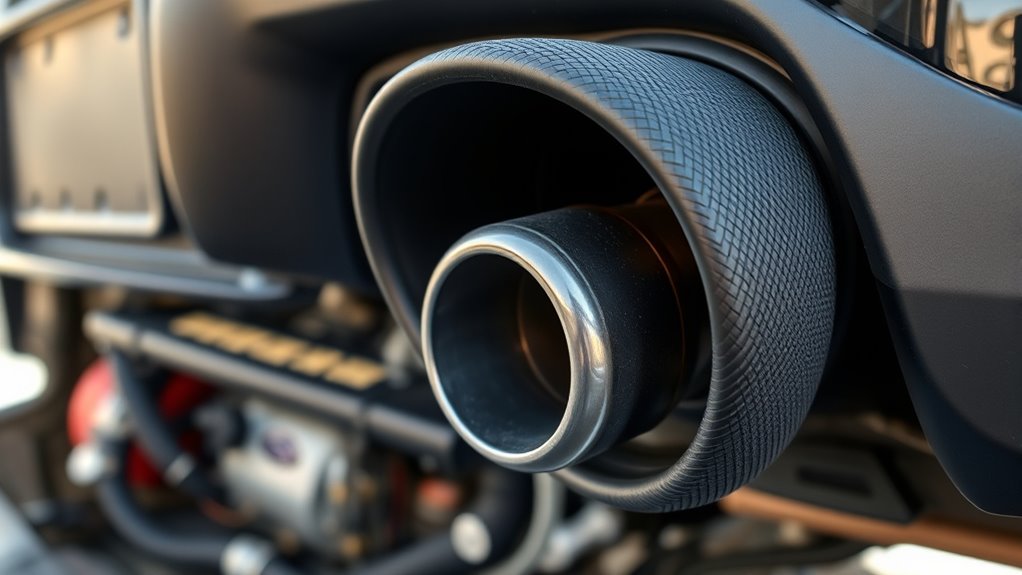
To guarantee that the performance benefits of exhaust wraps last, you need to prioritize their durability and safety. Choose high-quality materials like titanium or ceramic, which resist oil, abrasions, and moisture better than fiberglass. Proper installation is essential—use correct techniques and high-temperature coatings to prevent damage and corrosion. Regularly inspect the wraps for cracks, brittleness, or flaking, especially in harsh environments with snow and salt that can accelerate deterioration. Ensure the wrap is compatible with your stainless steel exhaust components to avoid safety hazards. Protect the wrap from moisture and physical damage during maintenance. Reapply or replace the wrap when necessary, and monitor engine performance to confirm effective heat retention. These steps ensure your exhaust system remains safe and durable over time. Additionally, choosing proper materials that align with environmental sustainability can help extend the lifespan and performance of your exhaust wrap. Recognizing the importance of material properties such as heat resistance and corrosion resistance can further enhance the longevity of your exhaust insulation. Incorporating innovative insulation solutions can also contribute to better heat management and durability, supported by ongoing advancements in AI-driven research.
Cost-Effective Upgrades: The Value of Exhaust Wraps for Subaru Models
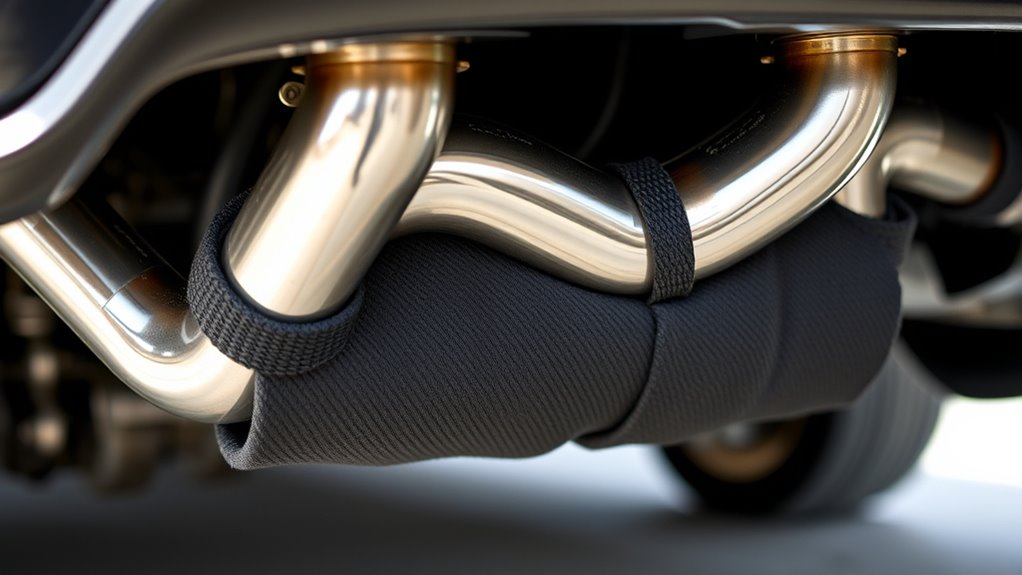
Exhaust wraps offer a cost-effective way to boost your Subaru’s performance without the need for expensive full exhaust system upgrades. Basic wrap kits start under $50, making them accessible for most budgets. They reduce the need for costly heat shielding by retaining exhaust heat internally, which minimizes heat-related damage to nearby components. This leads to improved horsepower efficiency by maintaining higher exhaust gas velocity, enhancing scavenging without pricey modifications. Additionally, wraps lower the risk of radiator and intercooler heat soak, potentially reducing future cooling system repairs. They’re compatible with OEM parts, avoiding expensive aftermarket exhaust replacements for mild performance gains. Incorporating heat retention techniques can further optimize engine performance and longevity. Moreover, implementing space-saving strategies when installing wraps can facilitate easier maintenance access and help keep the engine bay organized. Proper installation also ensures maximum heat management benefits, enhancing overall vehicle reliability. Overall, exhaust wraps deliver noticeable performance improvements and heat management benefits at a fraction of the cost of more extensive upgrades.
Maintenance and Care of Exhaust Wraps in Subaru Engines

Maintaining your Subaru’s exhaust wraps is essential for ensuring their longevity and peak performance. You should remove contaminants immediately using a degreaser and a stiff brush to prevent residue buildup. Always dry thoroughly after cleaning to avoid moisture that could degrade fibers or cause rust. Avoid harsh chemicals, as they can compromise the wrap’s silica or fiberglass material. During oil changes, protect the wrap with foil to prevent fluid absorption, and inspect for stains afterward—trapped fluids increase fire risk. Regularly check for fraying, discoloration, and fastener tightness, especially every 5,000 miles. Replace wraps every 2–3 years to maintain insulation integrity. Wear gloves and masks when handling old wraps, and keep a fire extinguisher nearby during initial engine runs for safety.
Enhancing Engine Bay Heat Management for Subaru Outback and Forester

Enhancing engine bay heat management in your Subaru Outback or Forester involves using high-quality exhaust wraps that effectively contain and direct heat. These wraps, made of fiberglass or ceramic materials, withstand high temperatures and keep heat within the exhaust system. Installing tight-fitting wraps ensures ideal heat retention, which can boost engine performance by increasing gas velocity and improving exhaust flow. Proper insulation also reduces extreme temperature fluctuations in the engine bay, protecting nearby components like hoses and wiring from heat damage. Additionally, these wraps help distribute heat more evenly, lowering overall engine bay temperatures. This not only enhances durability but can improve fuel efficiency. When installing, consider material thickness, wrap style, and ensuring a snug fit for maximum benefits in both Subaru Outback and Forester models.
Frequently Asked Questions
Can Exhaust Wraps Affect the Warranty of My Subaru?
You might wonder if exhaust wraps can affect your warranty. Generally, installing them can void parts of your vehicle’s warranty because they alter the exhaust system and may cause damage over time. While Subaru doesn’t specifically mention wraps, any modification that impacts the original setup could risk coverage. To avoid issues, consider consulting your dealer or warranty policy before installing exhaust wraps.
Are Titanium Wraps Suitable for Daily Driving Subaru Models?
You wonder if titanium wraps are suitable for your daily-driving Subaru. They’re a great choice because they resist oil contamination, withstand temperatures over 2000°F, and don’t break down easily from vibration. Plus, they help keep engine bay temperatures down and improve exhaust flow. Just remember to regularly inspect for oil leaks or cracks, and guarantee proper installation with high-temperature ties. Titanium wraps can definitely handle daily driving conditions effectively.
How Long Do Exhaust Wraps Typically Last on Subaru Vehicles?
You might wonder about the lifespan of exhaust wraps on your Subaru. Generally, with proper maintenance and perfect conditions, they last around 1 to 5 years. Factors like climate, exposure to oil or moisture, and driving habits influence longevity. Regular inspections help catch early signs of wear or corrosion. Choosing high-quality materials and ensuring correct installation can extend their performance, keeping your exhaust system protected and functioning ideally over time.
Do Exhaust Wraps Require Any Special Cleaning or Maintenance?
You should clean exhaust wraps carefully to maintain their integrity. Use gentle chemical cleaners like brake cleaner or mild detergents, and blot instead of rubbing. Avoid high-pressure washes, which can damage fibers. Regular inspections help spot damage early. After exposure to contaminants, dry the wrap quickly. Keep the wraps shielded from UV exposure and road debris, and replace any frayed or brittle sections to guarantee longevity.
Will Wrapping Headers Interfere With Future Repairs or Replacements?
Wrapping headers can complicate future repairs or replacements since it makes removing the headers more difficult. Over time, the wrap may deteriorate, become brittle, and cause peeling, which can hinder disassembly. You might need special tools to safely remove the wrap without damaging the headers. Regular inspections help prevent issues, but be prepared for potentially increased labor and costs if repairs are needed down the line.
Conclusion
Installing exhaust wraps on your Subaru Outback or Forester can reduce engine bay temperatures by up to 40%, extending component lifespan and improving performance. Not only do these wraps boost heat management, but they also enhance your vehicle’s efficiency and safety. With proper selection and maintenance, you’ll enjoy longer-lasting, cooler-running engines. If you’re looking for a cost-effective upgrade, exhaust wraps are a smart choice that delivers real benefits for your Subaru.



